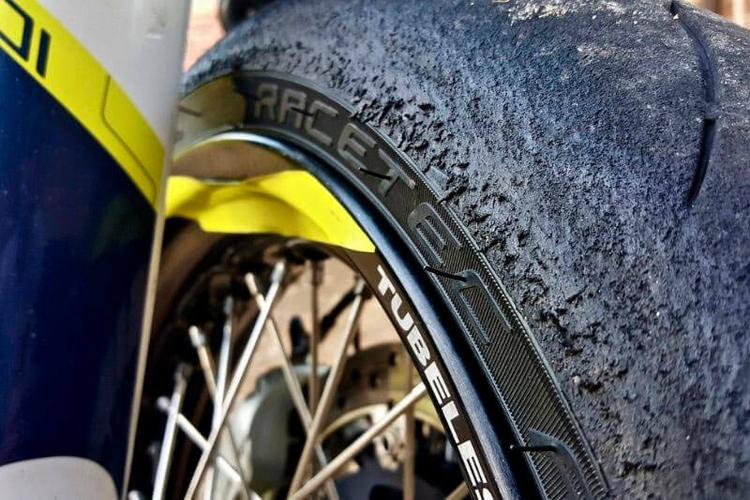
How long do motorcycle tires last?
Cracks, fractures, and cuts: Cracks on the sidewalls or in the rain sipes or tread develop when a tire is aging out. Fractures could indicate the tire is failing. Cuts come from impacts on the road. If you see any of these, replace that tire.
How far you ride: You, like most riders, use mileage as a measure to gauge tire life.
Maintaining our rides can be costly, but the consequences of riding on worn-out tires can be even more serious. That begs the question, how long do motorcycle tires last? Further, how can you help them last longer?
Balance lifespan, performance, safety, and value
When you’re in the market to replace your motorcycle’s tires, you want good value. Tire life seems to go hand-in-hand with price.
True value is achieving a satisfying balance between lifespan, performance, price, and safety. To do that, it’s important to understand all the things that affect how long motorcycle tires last.
Understand motorcycle tire life factors
Consider how these work in concert and contribute in varying degrees to tire lifespan:
- How far you ride: You, like most riders, use mileage as a measure to gauge tire life.
- How fast you ride: Speed creates heat and heat increases the treadwear rate.
- Seasonal maintenance: Correct cold tire inflation helps extend tire life.
- Motorcycle type: Manufacturers design and construct tires to match the bike type. For example, a sport bike will get a softer tire with more grip for aggressive cornering, but a soft tire won’t last as long as a touring bike tire made with harder compounds.
- Riding style: Are you a long-distance freeway cruiser, commuter, canyon-carving sport rider, or dual sport adventurer?
- Road hazards: Stuff happens on the road, like punctures and cuts, that can shorten your tires’ lifespan.
- Road surfaces: Frequent riding on rough road surfaces wears tires faster than smooth pavement.
- The load you carry: A heavily laden motorcycle and two-up riding will wear out a rear tire sooner than a front tire.
- Motorcycle tire construction: Some tires are made to be sticky and provide great grip. Other tires sacrifice grip to get higher mileage.
Motorcycle tire age
Before they leave the manufacturing floor, tires are dated. This sets their lifespan in motion. You can determine how old your tires are by checking the Tire Identification Number (TIN) on the tire sidewall. The last four digits tell the week and year of manufacture.
Motorcycle tire life beyond five years
Some manufacturers will tell you that you can ride on tires until they’re 10 years old. So, five or 10? Even if your motorcycle tires look good to you after five years from the date they were manufactured, have them inspected each year by a tire professional. Motorcycle tires never last longer than 10 years. If your bike’s tires are older than this, you need to replace them.
Tire tread
Manufacturers cut grooves called rain sipes into street tires to disperse water on the road and provide traction. If you look at the edge of the tread on the motorcycle tire sidewall, you’ll find tread wear indicator (TWI) markings. At the TWI, you’ll find a raised bar across the tire in the rain sipes. When the tread has worn down to be level with that bar, your tires are worn out. Order new ones now.
Check for motorcycle tire defects
Make inspecting your tires part of your routine, pre-ride motorcycle safety inspection. Motorcycle tires are vulnerable to wear and abuse from the road surface. Pull over and check your tires if you hit a pothole or run over debris.
Here are some tire defects you need to look for:
- Cracks, fractures, and cuts: Cracks on the sidewalls or in the rain sipes or tread develop when a tire is aging out. Fractures could indicate the tire is failing. Cuts come from impacts on the road. If you see any of these, replace that tire.
- Punctures: Running over a nail or other sharp object can puncture the tire tread. A thin puncture in the tread might be pluggable. View this repair as a temporary solution so you can get to a shop and replace the tire. You cannot repair a sidewall puncture.
- Inflation and pressure: Motorcycle tires need to be properly inflated when cold. Consider the load the bike is carrying when inflating. Riding with a passenger or heavy luggage requires a higher cold pressure. Never exceed the maximum pressure indicated on the sidewall.
- How the bike handles: If you notice a change in how your motorcycle handles, it may indicate your tires are wearing out. Abrupt sensations when cornering or braking or vibration on smooth straight pavement are signs of advanced tread wear. Inspect the tires or have a tire professional inspect them.
Choose to get new tires
Your motorcycle tires connect you to the road—which is why it’s dangerous to try and get the last possible mile out of your tires. When the tread nears the wear marks or looks like it’s wearing unevenly, or your tires are showing signs of aging, it’s time for a new set.